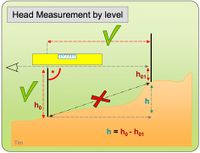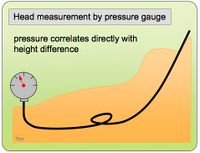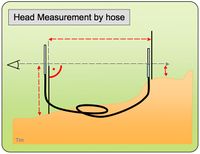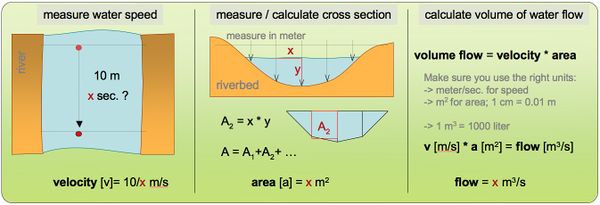The first step to judge a sites hydropower potential is to measure/estimate head and flow.
Head (the vertical distance between the intake and turbine)
Flow (how much water comes down the stream)
Head is very often exaggerated as is the flow rate, which varies over the year!
Wrong data occurs frequently. Confirmation of existing data is highly recommended!
Head and flow are the two most important facts of a hydro site. This will determine everything about the hydro system—volume of civil constructions, pipeline size, turbine type and power output. Inaccurate measurements result in low efficiency, high cost and scarcity of power.
For sophisticated methods how to inquire a sites feasibility, please check the Manuals section.
"Layman's book: How to develop a Small Hydro Site" may be a good start.
Methods of Head and Flow Measurement without Sophisticated Tools
Estimation of height can be done easiest if there is a steep slope (waterfall)by rope. Principle of a step by step head measurement:
By measuring total height step by step, it's crucial to do the bearing strictly horizontally. Ensure that by using a level or a water filled hose. Widely available are hoses and pressure gauges which allow the easiest method of height measurement. As longer the hose as less steps have to be taken to measure the total head.
Estimation of flow is very difficult without measurement. A quick and easy way to measure is the floating method
First, measure the waters speed at an steady flowing part of the river. Therefore drop some item and stop the time it needs for a certain distance to float. Second, do a sketch of the rivers cross section by measuring its depth every 20-50 cm so you come up with a grid showing the rivers profile from side to side. With this data its cross sections area can be calculated easily. Finally the flow volume results from (water) speed x (section) area.
Example:
A ball drifts 10 m in 12 s => speed = 10m/12s = 0.12 m/s.
Cross section => A1= 25 cm * 40 cm (0.25 m * 0.4 m) = 0.1 m2 ; A1+A2+ ... = A = 0.5 m2
Flow volume = 0.12 m/s * 0.5 m2 = 0.06 m3/s => 60 l/s
To estimate a sites potential cost its necessary to know additionally:
Pipeline (penstock) length
Electrical transmission line length (from turbine to consumer). As smaller the sites power output as higher the power lines cost share
Number of potential customers
Units and Power Estimations
Power: watts [W] or Kilowatts [kW] 1 kW = 1000W
Flow: 1 m³/s = 1000 l/s
Gross heat: height difference the water "falls down"
Net head: a little smaller than gross head. Gross head deducted by energy loss due to friction in penstock
Potential power ('electric)' is calculated as follows:
Power [W] = Net head [m] x Flow [ l/s] x 9.81 [m/s²] (est. gravity constant) x 0.5 (turbine/generator efficiency)
Potential power is estimated as follows:
Power output [W] = height [m] * flow [l/s] * 5
More accurate estimations take into consideration:
exact net head (intake to powerhouse)
exact flow (constant during the year?)
combined efficiency of turbine and generator (depends on quality, est. 60% = 0.6)
Example:
A 6 m high waterfall has 300 liter/sec => potential power est. : 6 m * 300 l/s * 5 = 9000 W = 9 kW
















0 comments:
Post a Comment